Geometric Simplification for Indirect Illumination Calculations
You can obtain a
PostScript version of this paper without some of the figures
.
You can also obtain a
PostScript file containing these figures
.
Digested Version
Abstract
We present a new method for accelerating global
illumination calculations in the generation of physically accurate
images of geometrically complex environments. In the new method,
the environment geometry is simplified by eliminating small
isolated surfaces, and replacing clusters of small surfaces with
simple, optically equivalent, boxes. A radiosity solution is
performed on the simplified geometry. The radiosity solution is
then used in a multi-pass method to estimate the radiances
responsible for indirect illumination. We present a preliminary
implementation of the new method, and some initial images and
timing results. The initial results indicate that using simplified
geometries for indirect illumination calculations produces images
in times significantly less than previous multi-pass methods
without a reduction in image quality.
Introduction
The concept behind a ray tracing/radiosity hybrid is to take
advantage of what each does best. Namely, a ray tracing solution
is excellent for handling near specular surfaces, but is too
expensive for diffuse ones; while a radiosity solution is best for
diffuse surfaces, but becomes too expensive for specular ones. A
classic hybrid approach is to first run a radiosity solution on the
environment with the specular reflections ignored. Then an image
is created with ray tracing. When rays bounce from a surface with
the intent of gathering specular reflections, processing continues
as usual. Suppose though, that a ray is sent to gather for a
diffuse reflection. When the surface intersected is found, the
radiosity value stored during the radiosity pass is returned and no
further processing is necessary since this value is the result of
all diffuse reflections. This definition is somewhat simplified
but should suffice here. Unfortunately, although a complete
radiosity solution for the diffuse energy transfer is less
expensive than a ray tracing solution, it is still quite expensive.
Extended Hybrid Algorithm
The extended hybrid method will simplify the environment used by
the radiosity pre-pass since the information is only used for
diffuse reflections. Surfaces of a small enough size are
eliminated and groups of large numbers of small surfaces forming
objects are replaced by clumps as shown in Figure 1. Even diffuse
surfaces have detailed reflections at close range, so the radiosity
values will only be used at a distance of atleast rthresh.
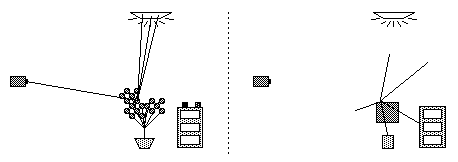
Figure 1: (Left) Rays from the eye and rays to the light source
intersect the detailed environment. (Right) Rays for calculating
indirect illumination intersect the simplified environment.
Remember that the radiosity pre-pass solution is not meant to be viewed
as an accurate final image itself. It is part of the solution which relies
on the Monte Carlo path tracing pass to complete the solution.
The solution method then, has three types of surfaces: normal,
complex and simple.
- Normal surfaces are large enough to be used both in the
radiosity solution and in the final rendering.
- Complex surfaces are small and are not used in the radiosity solution,
but are used in the high resolution pass of the final rendering.
- Simple surfaces are used in place of clusters of complex surfaces in the
radiosity solution and during the low resolution requirements of
the final rendering.
Small Isolated Surfaces (Complex Surfaces)
The first issue is how small must an isolated surface be to be
ignored in the simplified solution? If we assume that the diffuse
non-light source surfaces have radiances of approximately the same
order of magnitude relative to the radiance of the light sources,
the importance of a surface can be estimated by the solid angle it
subtends.
A conservative estimate wmax of the solid angle subtended on
i by another surface j is
wmax = A / r2
where r is the minimum distance from i to j,
and A is the area of j. The actual solid angle subtended
will be less than wmax since r is
the minimum distance, and because of the omission of a cosine term.
Now specify a wthresh so that any surface with a
wmax
less than wthresh with
respect to every other surface can be discarded because it will
have relatively little effect on the weakly directional component of
light for any other surface.
We can now throw out any surface which is small enough with respect
to all other surfaces, but calculating wmax for each surface
from every other surface is an O(N2) problem. To avoid
this cost,
remember that we will only use the radiosity results when a ray has
traveled a distance of atleast rthresh. When this is
the case, we can then calculate an area Athresh where
any surface smaller can be removed:
Athresh = wthresh *
rthesh2
Clusters of Small Surfaces (Simple Surfaces)
While small isolated surfaces will have little effect in a lower
detail version of the environment, a cluster of small surfaces
will. A simple way to account for the effect of clusters of
surfaces is to replace them with a box that is in some sense energy
equivalent. The box should provide an energy reflection
distribution that is reasonably equivalent to the original surface
cluster.
Defining a Cluster
The method for creating simplified equivalent clusters is shown in
Figure 2. First, a cluster of small surfaces which could be clumped
is manually chosen. A minimum bounding box is fit around the
cluster. Each face of the box is discretized into patches, and
then the algorithm cast a series of randomly selected rays
perpendicularly through each face of this bounding box.
The transmittance of the box is represented
by shrinking the box according to the percentage of rays that pass
through. The reflectance of each patch is set the average
reflectance of the surfaces hit while firing rays through that patch.
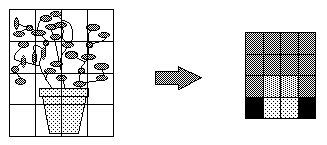
Figure 2: Patches on the bounding box have reflectance equal to the
average reflectance "seen" through the patch. The box is then
shrunk to the volume of the enclosed objects. Note that a patch is
the average color of the surfaces with no regard for "white space."
Also note that a patch with no objects becomes "black" (has a
reflectivity of 0). The fact that rays make it through is
accounted for by the shrinking of the box.
Results
Notice that this algorithm requires that a user specify the clumps
manually. Also, the hierarchy is only one level deep. These
simple choices were made in part as a result of not understanding
the options available at the time the research was began. It turns
out that the results were quite favorable despite these limitations.
To evaluate the effectiveness of GSII, we built a test environment
composed of 10,948 surfaces. These surfaces made up the objects in
an office including thumb tacks, pens, a computer keyboard and a plant.
The detail in the environment, as rendered by GSII, is shown in the three
figures below. (Note: Click a figure to get a more detailed [larger]
image.)
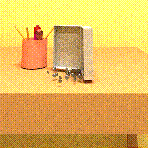
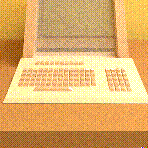

The radiosity pass of GSII always used the clumps in place of its
represented primitives. This solution is at a loss of resolution
but a gain in speed. The simplified environment solution was found
in less than 1 hour whereas the original environment was halted
after running over 142 hours.
During the ray tracing pass, values from the radiosity solution of
the simplified environment were returned. However, if a ray leaves
a surface with the intent of collecting diffusely reflected light
and the surface intersected is too close, the ray assumes that the
lower resolution of the simplified environment will produce an
unacceptably coarse approximation and continues normally without
returning the radiosity value. As a result, the ray tracing pass
took longer than a standard hybrid solution but produced images with
less artifacts. A classic hybrid solution
took 219 minutes and GSII took 254 minutes or 16% longer.
Considering both passes, the hierarchical environment saved time
and produced a picture as good as or better than the classic solution.
The following figure show the output of the radiosity pre-pass which isn't
meant for viewing; but only a low resolution first pass.
(Note: Click the figure to get a more detailed [larger] image.)
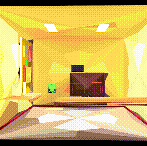
Finally, the following figures compare
a monte carlo path tracing solution (top left).
to
a full environment radiosity solution (top right),
a classic hybrid solution (bottom left),
and
a GSII hierarchical solution (bottom right)
.
(Note: Click a figure to get a more detailed [larger] image.)
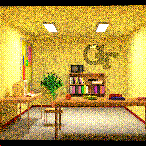
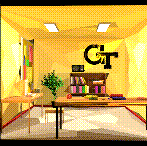
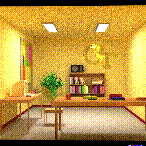
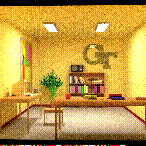
The monte carlo path tracing solution would take too long to complete and
produces much more noise error for a given number of rays.
The full environment radiosity solution would likewise take too long and
produces too many artifacts for a given number of iterations.
The hybrid solution is good, but its radiosity pre-pass was slow and it
produces some annoying artifacts (such as the confusing reflections on
the Georgia Tech wall plaque.)
The GSII hierarchical solution saves much time in the radiosity pre-pass,
and produce images with a total noise similar to the hybrid solution, but
with less annoying local artifacts.
Acknowledgements
This work was supported by grants from the National Science Foundation and
the Apple Computer Company.
For more information, please contact
Holly Rushmeier,
Charles Patterson, or
Aravindan Veerasamy.










